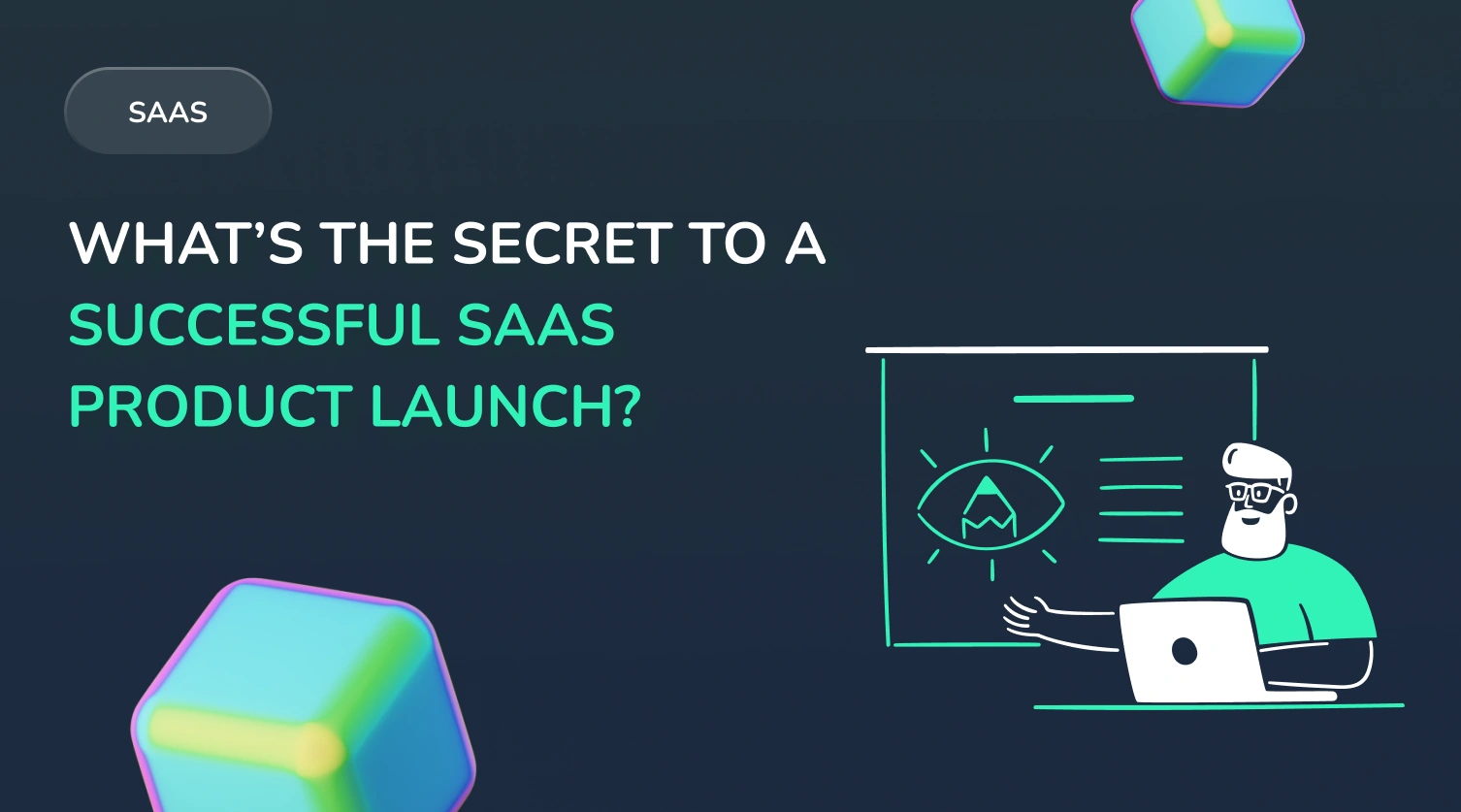
Your SaaS product is ready — what’s next?
In the previous article, we discussed an important decision: do you need a custom AI solution, or is an off-the-shelf product enough? If you’ve made it this far, you’ve probably realized that you want to create something of your own — unique, effective, and truly needed in the market. Congratulations: that’s already half the battle.
But there’s one catch. Even the most innovative and powerful SaaS product can fail if its launch is not well-planned. We’ve seen this happen dozens of times: the idea is great, the team is strong, but there are no users.
Why? Because there was no go-to-market plan.
In this article, we’ll walk you through the steps, without the unnecessary “tech jargon” on how to launch a SaaS product smartly, so that it starts delivering value and profit from day one.
Step 1. Who Are You Really Helping?
The simple truth is: you can’t build a product in a vacuum. Even if you’re confident you understand your audience, it’s not guaranteed that they think the same way. People rarely buy just for features. They buy solutions to their problems, relief from pain, peace of mind for the night.
That’s why understanding your target audience is not a “marketing whim,” but the foundation of a successful SaaS product.
💬 Many founders come to us saying, “We have a great technology, now we just need to find out who needs it.” Unfortunately, this is a path to nowhere. The classic product approach is to first understand the problem and then build the solution.
Here, the concept of a “buyer persona” comes into play — a generalized, yet plausible image of your ideal customer. Not just “a 35-year-old female marketer,” but:
- Where does she work?
- How does she make decisions?
- What does she fear?
- Who does she trust?
- What words does she use in Google searches?
- What does her typical workday look like?
For example, if your product is a B2B solution for contract automation, you might think your customer is the legal department. But if you dig deeper, you may find that the real pain point lies with the assistants who manually collect files and struggle to find the most up-to-date version.
What Can a Business Owner Do Right Now?
✅ Recall 5-10 of your real customers and write down the common traits. This will give you a starting point for creating your buyer persona.
✅ Conduct 20-30 minute interviews with potential users. Don’t sell; just listen. Good questions include:
- “How do you currently solve this problem?”
- “What don’t you like about it?”
- “If you had a ‘magic wand,’ what would you improve?”
✅ Read reviews of similar products on sites like G2, Capterra, Product Hunt, Reddit, and even the App Store. Customers literally shout out what’s important to them — listen carefully.
According to HubSpot, companies that regularly update and use buyer personas in marketing and product development can significantly improve their website’s effectiveness and user experience, making it 2–5 times more impactful for their target audience.
OpenView has highlighted the importance of customer-centric approaches for SaaS teams, emphasizing that starting with user interviews and gathering direct feedback from potential customers can lead to a better product-market fit and faster scaling. By focusing on real user needs, SaaS companies can iterate more effectively and reach scalability more quickly.
Creating a buyer persona is not about guessing; it’s about paying attention and respecting real people.
Your product needs to speak the customer’s language, solve their pain points, and be where they’re looking for it. Otherwise, you’re just shooting in the dark, hoping to hit the target.
Step 2. Test the Idea Before You Invest in Development
One of the most common scenarios: a founder spends 6–8 months and tens of thousands of dollars developing the perfect SaaS product, only to face silence after launch no registrations, no payments. Why? Because they built the product based on assumptions, not facts.
MVP — Not a “Raw Version”, but a Hypothesis Test
An MVP (Minimum Viable Product) is not a “rough draft” or a “test version”; it is a tool to test ideas with real users. Its goal is not to sell but to find out:
- Does the customer really have a pain point?
- Does your solution actually address it?
- Is the customer willing to pay for it (or at least continue using it)?
Research has shown that 42% of startups fail due to a lack of market demand. An MVP helps avoid this trap — quickly, cheaply, and without the pain.
How MVP Saves Money
- You don’t waste months and budgets on something that no one will use. It’s better to fail on a prototype for $1,000 than on a full product for $100,000.
- You focus only on solving the customer’s specific pain. No unnecessary features “just in case” that no one asked for.
- You get feedback before a full-scale release. This lets you improve the product with real users, not by guesswork.
How to Test an Idea Without Writing a Line of Code
If you think that building an MVP requires hiring a CTO or a development team, we’re happy to tell you that it’s not necessary. Here are some proven approaches tested on hundreds of SaaS startups:
- Interactive Prototype (Figma, Marvel, InVision)
This clickable “image” shows how the product would work if it were already built.
💡 Great for presenting to investors, first customers, or focus groups.
- No-code/Low-code Tools (Bubble, Glide, Softr, Webflow)
These tools allow you to create an MVP in just a few days, without developers.
For example, one of our clients launched a platform for equipment rental using Bubble and got their first paying users before the backend development even began.
- Single-Page Website with a “Sign Up” Button
Yes, just a landing page. Explain the problem, the solution, the pricing — and add a form. If no one clicks the “Sign Up” button, the problem may not be as urgent as you thought.
Dropbox tested the idea with a video presentation. There was no product yet, but the waitlist for beta access grew exponentially. That’s the power of MVP.
🚫 Common Mistake: “Falling in Love with Your Product”
You are not your SaaS. You don’t have to defend it at all costs. Fall in love not with the idea but with the customer’s problem. Be ready to change the direction, interface, or business model — if that’s what the market demands.
In our practice, there was one case where a startup began with an online webinar platform, and after a series of MVP experiments, it became an automatic reporting service for B2B. Because customers valued data, not webinars.
Key Takeaway: Test Cheaply, Learn Quickly
MVP is all about speed and flexibility. A successful launch doesn’t start with the perfect product; it starts with a real understanding of what your customers need. Everything else is just technical detail.
Step 3. Preparing for Launch: Team, Content, Strategy
The product is ready. The MVP has been tested, and the first users confirmed: “Yes, this is what we need.” Is it time to hit the gas? Almost. But before that, use your head, not just your heart.
Launching without a strategy is like sailing into the sea without a map. Even with a good boat and crew, you risk drifting in the wrong direction.
What is a Go-to-Market (GTM) Strategy — Simply Put
GTM is your route from “we have a product” to “we have paying customers.” It answers 3 key questions:
- Who is our customer?
- Where do they live?
- How will we communicate value to them?
A HubSpot survey showed that companies with a well-defined GTM strategy achieve their first sales 50% faster than those who rely on intuition.
The Minimum Needed to Enter the Market
It’s not a “big marketing campaign.” It’s a sensible start to understand if your sales funnel works. Here’s the basic kit:
✅ 1. Landing Page or Single-Page Website
No branding or philosophy. Just clearly: what you solve, for whom, and how. Our experts recommend using the structure: Problem → Solution → Proof → CTA (Call to Action). For example, Calendly’s first landing page simply said: “Schedule meetings without email back-and-forth.” That’s it.
✅ 2. Email Campaign or Lead List
A subscriber base is gold. Even 100 people who’ve agreed to be contacted is the beginning of a live sales channel. You can collect it through a mini-landing page with a lead magnet: checklist, PDF, or free access.
✅ 3. Presence Channels: Not “everywhere at once,” but “where your audience lives”
- LinkedIn — for B2B (especially SaaS, consulting, HR, fintech)
- Reddit — great for niche solutions, especially if you’re addressing a specific community’s pain
- Instagram/TikTok — B2C, especially for visual products (fitness, lifestyle, cosmetics)
- Product Hunt, Indie Hackers, BetaList — if you have a digital product to show to the startup community and early adopters.
Content — Not Just a “Blog,” But Your Selling Story
When you’re small, content becomes your salesperson, PR manager, and advocate. It explains why you’re not just another startup.
For example, if you’ve developed a SaaS for managing micro-teams, you could start a blog with case studies from freelance managers. Based on a case from our practice, we noticed a 370% increase in organic traffic in 2 months — without advertising.
Content can vary:
- Customer stories and their pain points (in a “Before/After” format)
- Personal — why you started this in the first place
- Step-by-step guides (“How we automated HR in a startup without an HR department”)
- Comparisons (e.g., your approach vs. Excel)
Team: Without It, the Launch Turns into Chaos
One of the common mistakes in early-stage SaaS is the founder doing everything. It sounds cool in theory. In practice, it means you won’t have time to do anything deeply.
By the time you launch, you should at least have roles (even if one person fills multiple):
- Product Owner — the person who knows what and why is being built. This can be you.
Technical Executor — a developer, CTO, or agency who quickly fixes bugs and implements feedback. - Marketer/Communicator — the person who translates features into benefits and communicates them to the audience.
Once, we worked with a startup that got 1,500 registrations in the first week. But no one checked if the payment system worked. The tech person was freelancing, and the bug with Stripe was fixed after 3 weeks. They lost hundreds of potential payments. A team is critical.
Step 5. After the launch: it’s just the beginning
At this point, many entrepreneurs finally relax and think the launch is the end. But in reality, launching is only the start. Think of it as the beginning of a marathon, not the finish line. It’s important to understand that building a successful SaaS product takes constant attention and improvements.
What should you track?
After launching your SaaS platform, you need to stay alert and keep an eye on a few key metrics:
- How many people use the product
This simple number shows how much your product is needed. Start with the basics — how many users signed up. Later, dive deeper into user activity. - How much they pay
Revenue shows the value your product provides. It also helps you decide which monetization model to use. If users are paying, it means they see real value in your product — it’s not just numbers on a screen. - Which features are used
Not all features will be used equally. Track which ones are popular and which are ignored. This will help you decide what to improve and what to remove. - Where users drop off
Analyze at what stage users leave. It could be because the sign-up is too complicated, the interface is hard to use, or the product is missing key features.
How to track all of this?
You don’t need to be an analyst. In the beginning, simple tools like Google Analytics, Google Sheets, or your product’s built-in analytics are enough. Even a basic dashboard can give you the data you need. Don’t overcomplicate — focus only on what really matters.
Iteration and growth: the key to success
After launch, you begin a cycle of updates and improvements. Don’t worry if something doesn’t work right away. Listen to your users and improve the product based on their feedback. For example:
- If users often ask for a feature, strengthen it, upgrade it, or expand it.
- If a feature gets no attention, maybe it’s too basic — or maybe it should be removed.
Be careful: don’t add too many features too early. It’s better to launch a product that solves one or two main problems well than a product with ten confusing options that scare users away.
Common mistakes after launch
🚫 Scaling too soon
At the start, it’s important not only to collect feedback and validate demand but also to make sure you have the resources to support and grow your product. Don’t rush into new markets before stabilizing your current one.
🚫 No clear USP (Unique Selling Proposition)
If your product doesn’t solve a real problem, or if it’s hard to explain why people should use it, it will be difficult to keep their attention. Make sure your USP is clear and easy to understand.
🚫 Too many features
A product that is too complex or overloaded from the beginning can scare users. Make sure your interface is simple and easy to use. In the early stage, offer less, but make it valuable. The rest can come later.
Don’t try to add everything at once. Your first version should be useful, clear, and easy to use. Sometimes, “less is more” is the best strategy. It helps you get fast feedback and reduce risks.
Wrapping up
Launching is a hard process. But you don’t need to be a technical expert to succeed. You are the expert in your business — you know the problem your product solves. But you don’t have to master architecture, UX, or marketing.
At Corpsoft Solution, we don’t just build digital products — we become part of your team. We help you create a clear and effective path to launch your SaaS product, even if it’s your first time. We’ll support you at every step so your product succeeds — and you can focus on growing your business.
Subscribe to our blog

